Is there a role for treatment-oriented surgery in liver metastases from gastric cancer?
2020-09-14
Fabio Uggeri,Lorenzo Ripamonti,Enrico Pinotti,Simone Famularo,Luca Gianotti,Marco Braga,Fabrizio Romano,School of Medicine and Surgery,University of Milano-Bicocca,Department of Surgery,San Gerardo Hospital,Monza 20900,Italy
Mauro Alessandro Scotti,Mattia Garancini,Department of Surgery,San Gerardo Hospital,Monza 20900,Italy
Abstract
Key words:Hepatic metastases;Gastric cancer;Prognostic factor;Survival;Hepatectomy;Surgery
INTRODUCTION
Although the incidence of gastric cancer has declined in recent decades[1],it remains one of the most widespread malignancies.In the United States,27510 new cases were reported in 2019,with an estimated death rate of 40.5%[2].
Beyond the reduction in the number of cases,the aggressiveness of this disease has not changed.
Hematogenous dissemination is one of the main methods by which gastric cancer metastasizes,and the liver is one of the organs most frequently involved.Distant metastases are found in approximately 35% of patients with gastric cancer at their first clinical observation,and of these,4%-14% involve the liver[3,4].
Hepatic metastases from gastric cancer are diagnosed synchronously in about 3%-14% of patients,while metachronous lesions are diagnosed in up to 37% of patients after curative resection[5,6].Approximately 9% of patients with metastatic gastric cancer have only liver metastases at diagnosis[7].It is estimated that about 80% of metachronous liver lesions appear in the 2 years following curative gastric surgical resection[4],and only 0.4%-2.3% of the patients with metastatic gastric cancer are eligible for radical surgery[8,9].The 5-year survival rate of hepatectomy for gastric liver metastases is 13%-37%;however,its significance has not been established,and chemotherapy is the standard treatment today[8,10-14].
Unlike colorectal liver metastases,the greater biological aggressiveness of metastatic lesions from gastric adenocarcinoma leads,in most cases,to the presence of multiple and diffuse bilobar liver metastases in combination with peritoneal dissemination or lymph node involvement[15].
Although surgical resection for gastric cancer metastases is still debated,there have been changes in recent years.In fact,the last revision of the Japanese guidelines takes into account the possibility of surgically removing the metastatic lesions to obtain radical (R0) resection[16].
Surgery has potential benefit for a subset of patients with hepatic metastases[17],but several clinical issues should be defined:Indications for surgery,the role of postoperative medical therapy,and the duration of chemotherapy cycles.
Several prognostic factors must be taken into account for surgery to be proposed,and although there is no consensus,in the presence of potentially resectable metastases,surgical treatment should be a possible option.A recent review reported[18]5-year survival between 0% and 37%,with mean survival of 18.8%,for patients who underwent resection,while patients receiving only systemic chemotherapy had a poorer outcome.Although the data are difficult to compare because the patients undergoing surgery belong to a well-selected and more favorable population compared to patients with liver metastases treated with systemic chemotherapy,it is clear that surgery may play a role in treating this condition.
Moreover,it underlines how gastrectomy is more common in Eastern centers than in Western centers and that patients have better prognoses after gastrectomy in Eastern than Western centers[19].Although Western patients are diagnosed later,the better results observed in the East reflect a more aggressive attitude regarding this disease,highlighted by a larger number of curative resections even in the presence of resectable synchronous metastases[20].
On these bases,the purpose of the present study is to analyze in the current literature the clinicopathological factors related to primary tumor and metastases that impact the survival of patients with metastatic gastric cancer to the liver to clarify who would benefit from surgical treatment.
MATERIALS AND METHODS
Two authors (Uggeri F and Ripamonti L) performed a systematic review independently according to the Preferred Reporting Items for Systematic Reviews and Meta-Analyses (PRISMA) statement[21].
The study protocol was based on identifying studies with clearly defined purpose,eligibility criteria,methodological analysis,and patient outcome.Recent studies (over the last two decades) on the topic were considered,and we considered only the pertinent literature to better clarify the current indications for surgical treatment of patients with metastatic gastric cancer.
SEARCH STRATEGY
We performed a systematic search of the literature,updated in December 2019.We searched the PubMed (Medline) and Google Scholar databases using MeSH and free text words (tw) for gastric cancer and liver metastases.Some restrictions were applied:We searched only human full-text studies published in the last two decades,we considered only original studies in the English language,and discarded case reports.Some papers were subsequently discarded after discussion between the two reviewers because they were considered not strictly related to the topic considered (Figure 1).The quality of the studies was evaluated by examining three factors:Patient selection,compatibility with the research purpose,and evaluation of the results.
The following search strategy was used for the PubMed (MEDLINE) and Google Scholar databases:((“cancer” [MeSH] AND “gastric Neoplasms” [MeSH]) OR“neoplasm,stomach” [MeSH] OR stomach neoplasm*[tw] OR gastric neoplasm*[tw]OR cancer of stomach*[tw] OR stomach cancer*[tw] OR gastric cancer*[tw]) AND(“Metastases,Neoplasm” [MeSH] OR metastasis*[tw] OR metastases*[tw]) AND(surgery*[tw] OR resection*[tw] OR hepatectomy*[tw]) AND (hepatic*[tw] OR liver*[tw]).
RESULTS
We selected 47 studies from between 2000 and 2019 related to the purpose of the review,which involved a total of 2304 patients.All patients had liver metastases from gastric cancer and underwent surgical treatment.Patient sex was defined for 2212 patients:There were 1731 men (78.2%) and 481 women (21.8%).The median patient age was 54.9-72 years (Table 1).
The indications for hepatectomy consisted of good control of the primary tumor,no preoperative instrumental signs of disseminated disease,no extrahepatic disease,and the feasibility of R0 resection to maintain adequate postoperative liver function.Some studies reported the presence of metachronous metastases as an inclusion criteria and one study excluded patients with bilobar and diffuse liver metastases (H3).Sixmanuscripts analyzed the results on patients with extrahepatic disease,of which only two identified the variable as an unfavorable prognostic factor in the presence of R0 resection.
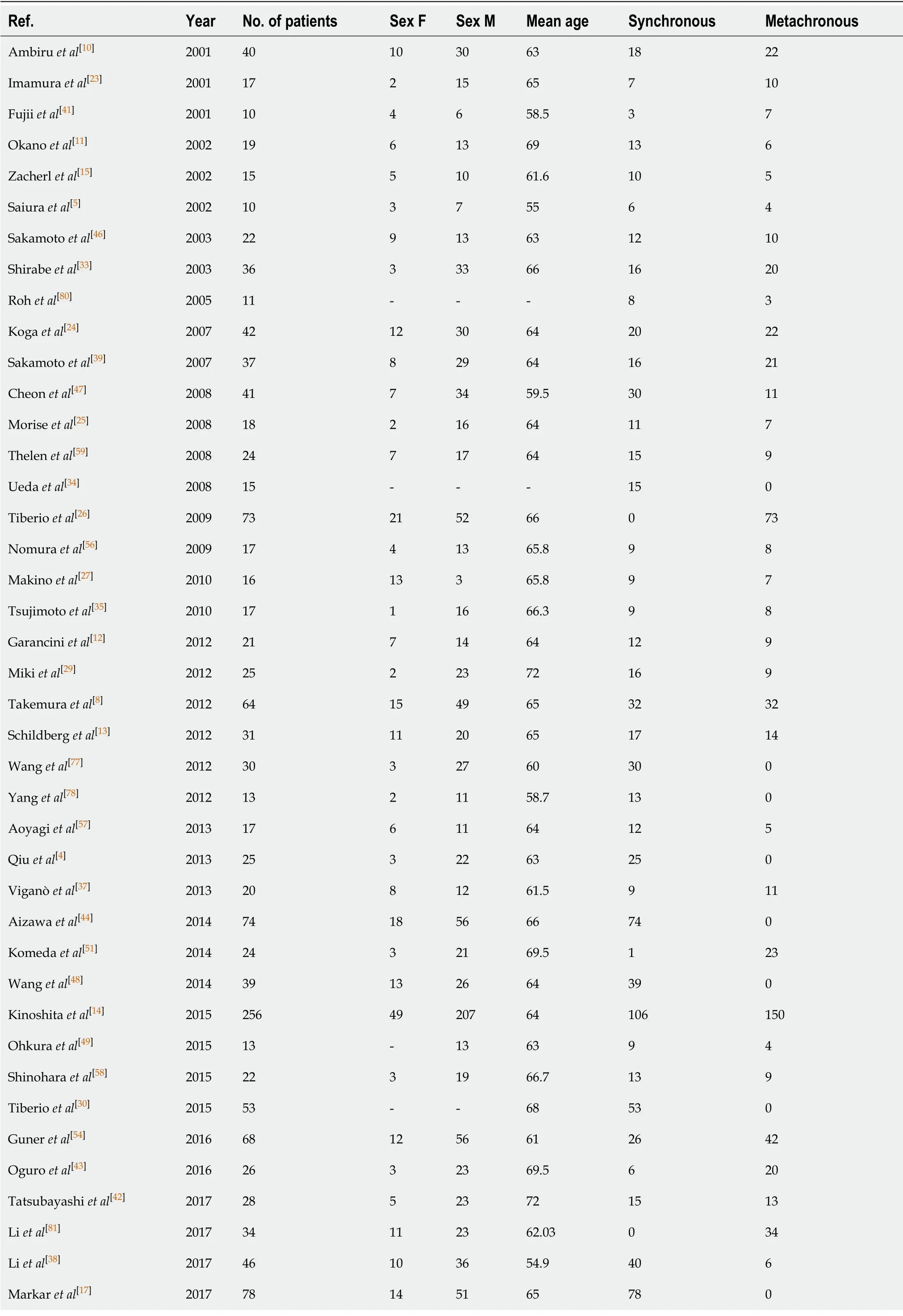
Table1 Patient characteristics

M:Male;F:Female.
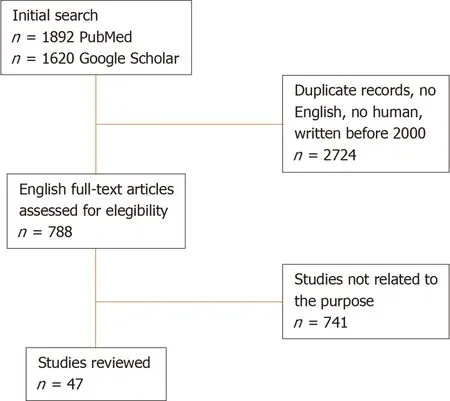
Figure1 Literature research.
Regarding the time of onset of liver metastases,most of the papers (n= 35) reported series with synchronous and metachronous metastases.Three authors described a series with only metachronous metastases,and nine papers contained only synchronous metastases.In patients with metachronous disease,the median interval between gastrectomy and hepatectomy was 9-47.3 mo.Liver disease was synchronous in 1241 (53.8%) patients and metachronous in 1063 patients (46.2%) (Table 1).
Overall survival (OS) is reported as median survival (expressed in months) and at 1,2,3,and 5 years;a few cases,reported the 10-year OS.Median survival was 7-52.3 mo;11 studies reported median disease-free survival (DFS) of 4.7-18 mo.The 1-,2-,3-,and 5-year OS was 33%-90.1%,10%-60%,6%-70.4%,and 0%-40.1%,respectively.Only five papers reported the 10-year OS,which was 5.5%-31.5%.Eight authors reported overall 1-,3-,and 5-year DFS of 30.8%-56%,10%-32.4%,and 7.7%-30.1%,respectively(Table 2).
Twenty-nine papers also reported patient survival 5 years after liver resection,defined as long survival,which numbered 208 patients with both synchronous and metachronous disease.The presence of patients who were alive at 5 years,although not reported in all studies,confirms that,in selected patients,liver resection of metastases from gastric cancer may bring yield prognostic benefit to the patient.
In most studies,perioperative mortality at 30 postoperative days was 0%;in five studies,it was 1.5%-10.3%.Altogether,16 patients died in the first 30 d after surgery:The confirmed cause of death was pneumonia in two patients and postoperative liver failure in one patient;in the remaining patients,the cause of death was not specified.
The majority of the studies reported on disease recurrence,which was reported in terms of general recurrence and intrahepatic recurrence only.The rate of general recurrence was between 55.5% and 96%,while that of for intra-hepatic recurrence was between 15% and 94%.
The analysis of the identified papers showed that the significant prognostic factorsassociated with primary tumor were lymph node stage (eight papers) and the depth of infiltration of the primary lesion (13 papers).The prognostic factors related to hepatic metastases were:Timing of the onset of metastases (15 papers);number (26 papers),size (12 papers),and bilobar distribution (11 papers) were considered independent prognostic factors (Table 3).
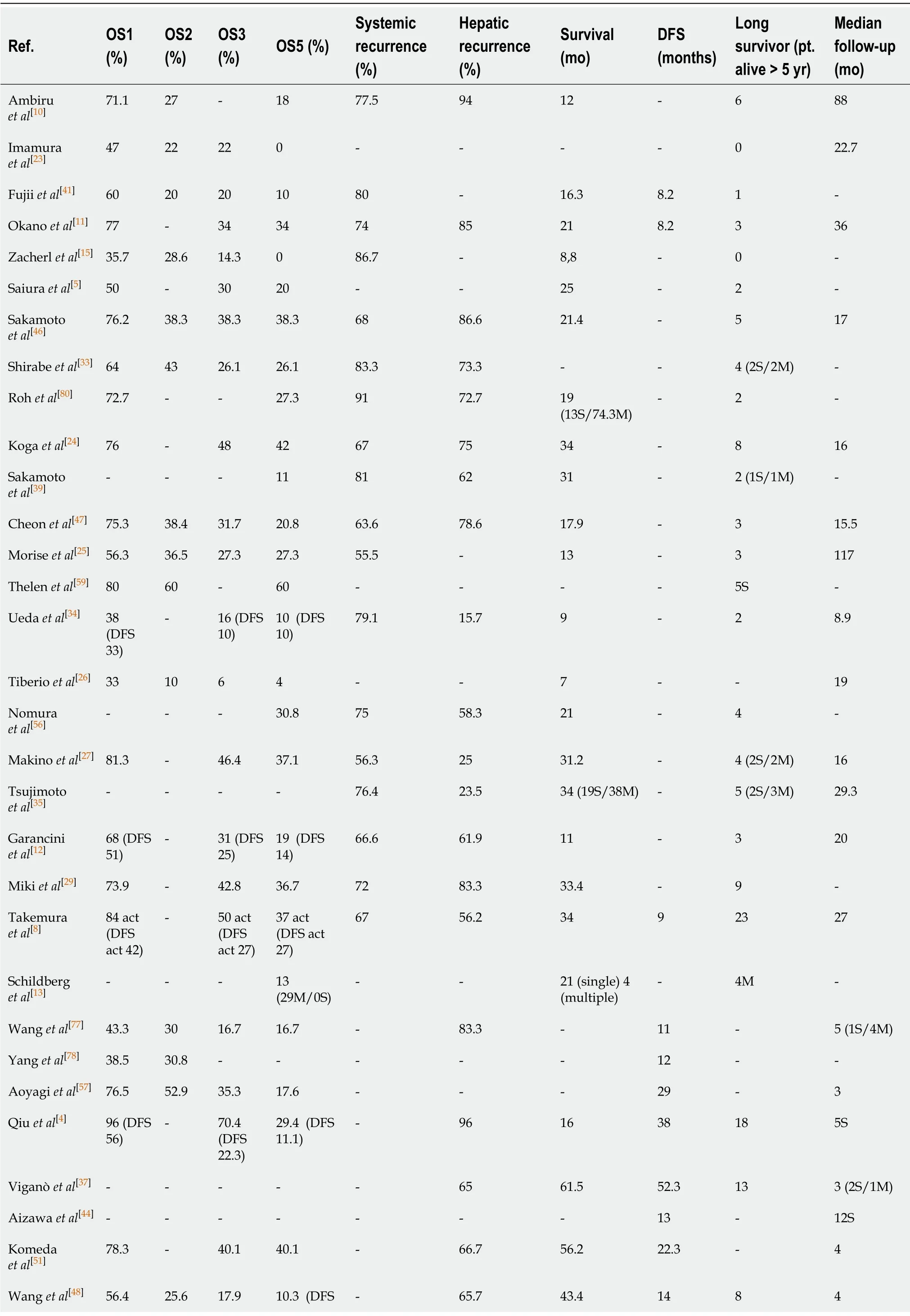
Table2 Results of the review
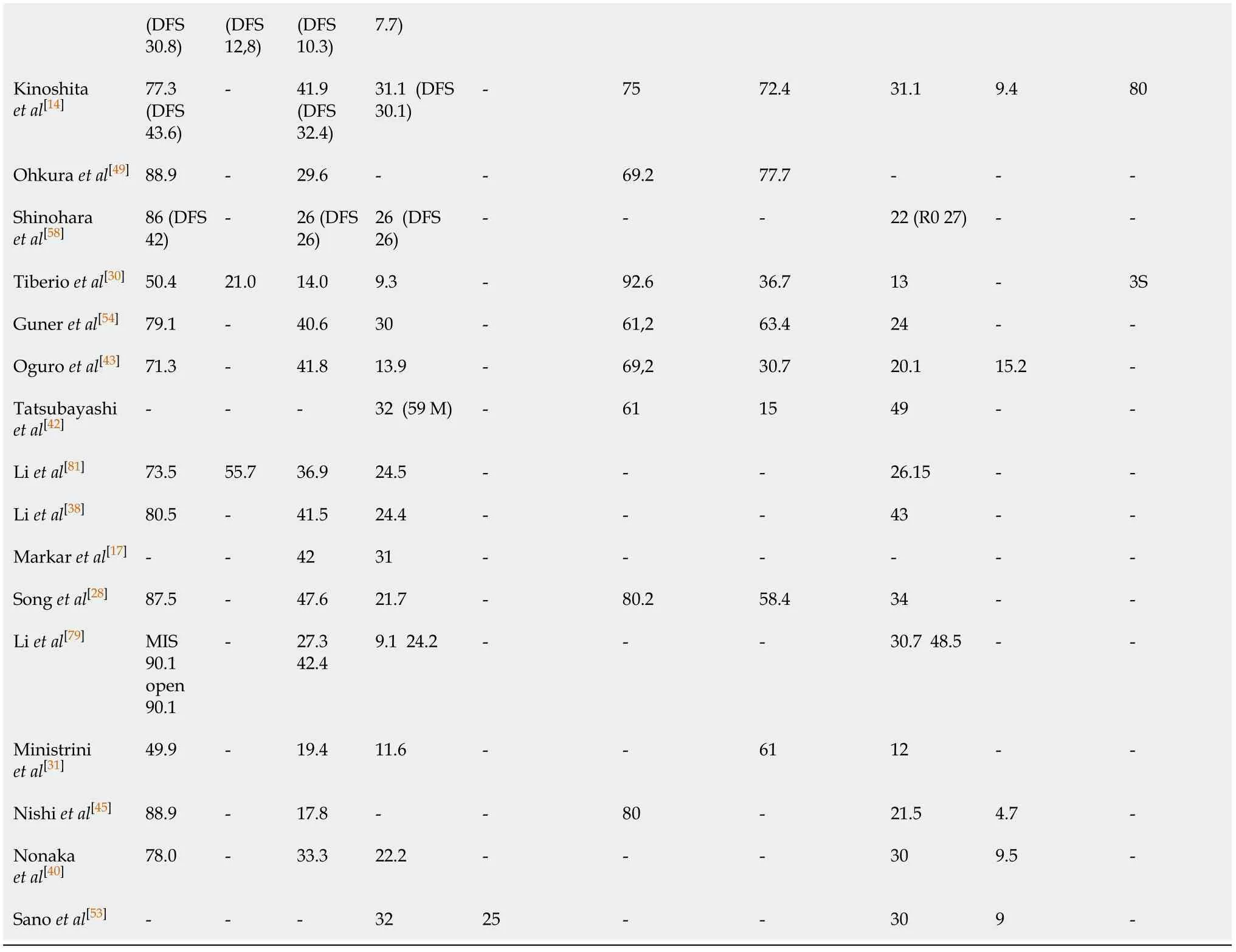
-:Missing or not clearly reported in the article;OS:Overall survival;DFS:Disease-free survival;S:Synchronous;M:Metachronous;MIS:Mini-invasive surgery;ACT:Actuarial survival.
The median follow-up was 8-117 mo (reported in 27 papers).
Prognostic factors associated to primary tumors
In 1994,one of the first studies on the subject[22]showed how the presence of serous invasion of gastric cancer was a determining prognostic factor in the resection of synchronous hepatic metastases.Since then,T stage has been extensively investigated[8,14,23-31].Serous invasion is the first step in metastatic spread to the peritoneal cavity,an unfavorable prognostic factor[22].A T stage ≥ 3 can be considered an independent prognostic factor for both synchronous and metachronous diseases[26,28,29].These data may have important implications in selecting patients for surgery,especially in cases of metachronous hepatic metastases.On the contrary,in the case of synchronous metastases,it is very important to accurately understand the depth of the primary lesion,as it does not allow an observation period for the development of peritoneal recurrence after gastrectomy.In this sense,the report of peritoneal lavage may be useful when considering hepatic resection[32].
Even at the metastatic lymph node stage,dissemination is to be considered when assessing the possibility of performing hepatic resection.In fact,several authors have shown that resected patients have higher survival if there is no lymph node involvement[5,26,33].The absence of lymph node metastases without peritoneal dissemination by the primary gastric tumor is a key factor for achieving a good prognostic outcome after liver resection for synchronous metastases[34].The degree of lymph node involvement (N1-3)[28]and therefore a proper D2 lymphadenectomy during gastrectomy plays a key role as a prognostic predictor[35,36].
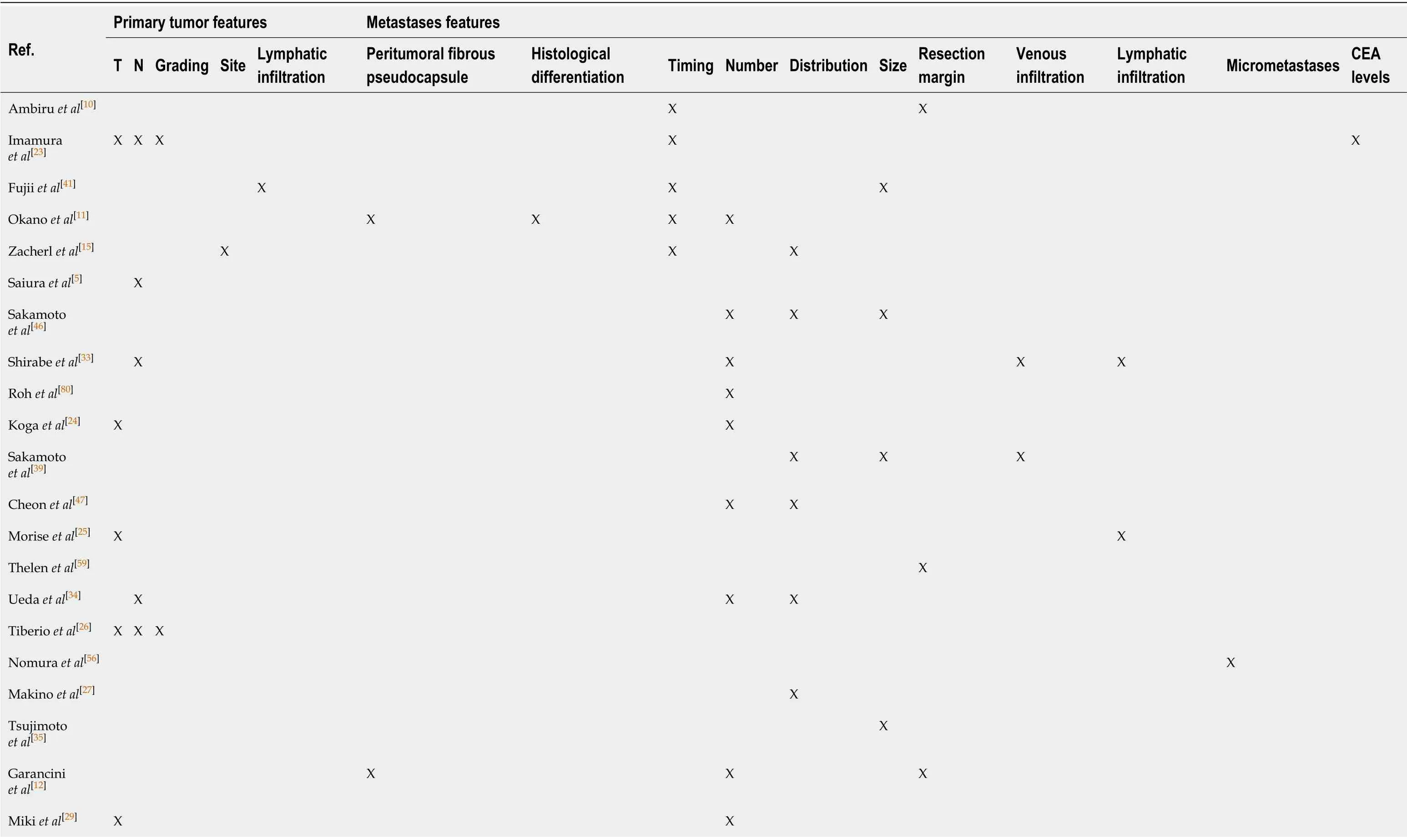
Table3 Prognostic factors related to primary tumor and metastases

Takemura et al[8]X X Schildberg et al[13]X X X Wang et al[77]X Yang et al[78]X X Aoyagi et al[57]X X X X X Qiu et al[4]X Viganò et al[37]X Aizawa et al[44]X Komeda et al[51]X Wang et al[48]X X Kinoshita et al[14]X X X Ohkura et al[49]X X X Shinohara et al[58]X Tiberio et al[30]X X Guner et al[54]X Oguro et al[43]X X X Tatsubayashi et al[42]X Li et al[81]X Li et al[38]X X Markar et al[17]X Song et al[28]X X Li et al[79]X X Ministrini et al[31]X X X X Nishi et al[45]X X X X Nonaka et al[40]X X X X X X X

T:T stage primary tumor;N:Limph-nodal status of primary tumor;CEA:Carcinoembryonic antigen.
The analysis of Tiberioet al[26]of the treatment of a group of patients with metachronous liver metastases highlighted how the correlation of the T stage and lymph node involvement is associated with poor histological differentiation of the gastric tumor and should contraindicate hepatic resection.
Few studies have validated that the site of the primary cancer and therefore the type of gastrectomy performed may have a significant prognostic role.Only one study[15]reported minor survival for patients with proximal gastric tumors compared to a distal site.This could be closely related to the increased aggressiveness of cardia as opposed to antral gastric tumors,but none of the several recent papers has confirmed these data[37,38].
On the other hand,the presence of lymphatic[14,25,27]and venous[33,39]infiltration of primary tumor,an expression of greater oncological aggressiveness,could also play an unfavorable prognostic role.
Finally,the presence of a gastric lesion of >5 cm should be considered an adverse prognostic factor[35,40].
Prognostic factors associated with metastases
The majority of the studies reviewed the time,number,and distribution of metastases as factors strongly associated with OS.The time of onset of the metastatic lesion has always been considered in the past[10,11,41],and is still considered in some more recent studies[42,43]as a prognostic factor.Several studies reported better prognosis in the case of metachronous hepatic metastases,especially if they appeared at >12 mo[41]after the removal of the primary lesion,a possible expression of lower oncological aggressiveness.However,the presence of a considerable proportion of patients alive at 5 years (range,16.3%-33.3%)[4,34,44]who had undergone resection for synchronous metastases has in part changed this attitude to date.Although there is currently no strong evidence of a better prognosis for synchronous metastases,many studies[17,40,45]in the last few years have not reported significant differences in OS when comparing synchronous vs.metachronous metastases.It is a sign that,at the current state of knowledge,the presence of synchronous metastases need not be considered a condition without any surgical options.
Among the items assessed,the prognostic value of the number of metastases was strongly confirmed in the literature.The presence of a single metastasis[4,11,24,28,34,46-48]was considered the factor that leads to better prognosis,but currently there is still no consensus on the cut-off to consider hepatic resection.In fact,although the presence of≤ 3 metastases did not significantly impact the prognosis[14,49],patients with even >3 metastases to whom surgical treatment was extended had lower survival than patients treated with chemotherapy alone[50].This confirms the limit of three metastases to recommend a surgical treatment.
On the other hand,the literature reported better survival for patients with hepatic lesions <5 cm[8,14,51,52],but in this case there was also no consensus.In fact,other authors[49,53,54]considered a maximum diameter of 3 cm as closely related to an increase in survival.In this regard,it is interesting to note how the presence of ≥ 3 metastases,lesion diameter of >5 cm,and advanced stage of serous infiltration of the primary tumor are related to poor prognosis[14,55].In fact,patients with a greater number of risk factors have a significantly lower 3- or 5-year survival rate after hepatectomy.The presence of any of these factors should be considered in the decision to refer patients to palliation compared to surgery[55].
We confirmed that radical resection with negative surgical margins (R0) is one of the key inclusion criteria for achieving curative treatment;in fact,the disease-free surgical margin is a factor closely related to survival.In 2001,Ambiruet al[10]identified a disease-free margin of at least 10 mm as an important prognostic factor,but at present,the concept has shifted towards obtaining a negative free margin.Although maintaining a defined distance from the tumor margin is not considered essential,in this regard it is interesting to note that the presence of perilesional micrometastases impacts the rate of recurrence and survival.The presence of the latter does not appear to be affected by any clinicopathological factor[56].This finding presents an interesting starting point for reflection.In the literature,a macro/microscopically tumor cell–free resection margin is a positive prognostic factor in univariate analysis[10,12,13,57,58]and even in multivariate analysis[59].In fact,the authors reported a 1-year survival rate of 0% for patients with positive margins.
Also,hepatic bilobar dissemination is a factor linked to worse prognosis[15,27,30,34,39,47].Interestingly,in contrast to the literature,a recent report[38]indicated how the distribution and number of liver metastases do not significantly impact on survival.This would present future therapeutic opportunities even in H2-H3 patients.This is in accordance with the 1998 Japanese Gastric Cancer Association proposal of H2 for a few lesions scattered in both lobes of the liver,and H3 for multiple diffusely distributed metastases in both hepatic lobes[60].
Other features of metastases,such as carcinoembryonic antigen/carbohydrate antigen 19.9 (CEA/CA19-9) levels,venous or lymphatic infiltration,histological metastases differentiation,and surgical type of liver resection,do not seem to be prognostic factors to be considered[27,39,46,53].
Lastly,it would be interesting to consider data on the presence of a peritumoral fibrous pseudo-capsule that could limit the neoplastic spread[11,12].
DISCUSSION
Gastric cancer survival is substantially different in Asian and Western countries.The better survival in Asian countries is due to the introduction of screening programs,based on the high incidence of this type of cancer in the region[61,62].This is shown in a higher rate of early diagnosis,with the cancer being detected at the early stages.In addition the different location,histology and risk factors explain some of the differences in Asian and Western patients with gastric cancer[63].Distal localization with structural intestinal morphology differentiation is more frequent in Asian countries than the predominance of proximal localization with diffuse histology in the Western countries[64,65].This is reflected in better survival in Asian countries.A high dietary salt intake in the Japanese is a significant risk factor for gastric cancer,and its association might be stronger in the presence ofHelicobacter pyloriinfection[66].These data must be taken into account based on the fact that the heterogeneity of the patient groups examined in the present review are from both Asian and Western countries.
As mentioned earlier,a factor to keep in high consideration is the histological classification of the tumor;according to the Lauren classification,gastric adenocarcinoma can be divided into two major histological types:Diffuse and intestinal[67].Lauren types have several distinct molecular and clinical characteristics,including etiology,carcinogenesis,epidemiology,and progression.The expression of human epidermal growth factor receptor 2 (HER2) is more common in intestinal-type cancer,and such patients have better outcome than patients with diffuse-type cancer[68-70].Some studies[71,72]have shown that the diffuse type has more angiogenic factors and microvessel density than the intestinal type;this explains the worse prognosis of such patients and their tendency to develop metachronous metastases.
Although not present in all the studies analyzed,histological differentiation was reported as a statistically significant factor of survival (Table 3);the data must be taken in account in the hypothesis of directing the metastatic patient to surgical treatment.
Based on our analysis,we believe that treatment-oriented surgery plays a role in liver metastases from gastric cancer.Patient selection plays a key role.The indication for surgery must be established after a multidisciplinary meeting.A patient’s performance status,co-morbidity,and the invasiveness of a hepatectomy for performing R0 resection must be evaluated.
Although both neoadjuvant and adjuvant chemotherapy is a fundamental step in treating patients with metastatic gastric cancer,in the studies analyzed,the heterogeneous treatments administered to patients in the last 20 years do not allow concrete conclusions to be drawn.Preoperative chemotherapy was administered less frequently than adjuvant chemotherapy in the cohorts analyzed in the present study,and the response to neoadjuvant chemotherapy should be considered an unfavorable prognostic index,thus avoiding futile surgery[73,74].In accordance with Viganò[37],who reported that although patients with and without neoadjuvant chemotherapy had similar 5-year survival rates (36.5%vs27%),stratifying patients according to their response to chemotherapy tended to improve survival,which became significant.Today,the key cytotoxic drugs of chemotherapy for gastric cancer include fluoropyrimidine,platinum,taxanes,and irinotecan,as well as molecular target agents,e.g.,the anti-HER2 antibody trastuzumab for HER2-positive gastric cancer,and the anti-angiogenesis agent ramucirumab combined with paclitaxel,which have been proven to improve the survival of patients with gastric cancer[75,76].
While some data reported,such as CEA level[22,29,52]and perioperative blood transfusions[8,23,42],do not seem particularly relevant,greater prognostic relevance has to be given to factors closely associated with primary cancer and metastases.
The lymph node stage is a factor to be considered in the resection of metachronous metastases;in fact,the level of metastatic lymph node involvement has an important prognostic role[5,26,28,33,34].This proves how essential it is to perform an adequate lymphadenectomy during primary tumor resection.
A similar prognostic role appears to be serous involvement of the primary tumor.T stage ≥ 3 can be considered an independent negative prognostic factor of both synchronous and metachronous metastases.Patients with lymph nodal metastases and T stage ≥ 3 should be carefully evaluated before being proposed for hepatic resection[26,28].
Although patients with a solitary metastasis are those with the best prognosis[4,11,24,28,34,46-48],in prognostic terms,even patients with <3 metastases may benefit from hepatic resection[14,49].
The timing of the onset of the metastatic lesion[10,11,41]is considered an essential prognostic factor,reporting better prognosis for metachronous metastases resections.Although the data are validated,to date the presence of several reports[4,17,30,34,44,48,77-79]reporting resections for synchronous metastases with overlapping survival to metachronous hepatic resection indicates that the presence of synchronous metastases should not be considered a patient exclusion criteria for liver resection.
Furthermore,bilobar distribution is considered a sign of disseminated disease,therefore with poor prognosis[15,17,27,30,34,39,46,78,79].Nevertheless,a recent study[38]showed how,in the presence of R0 curative resection,the distribution and number of liver metastases do not affect prognosis.This achievement,although it should be further investigated,could result in new therapeutic openings even for patients currently not considered eligible for surgical treatment.Moreover,the development of a parenchyma-sparing technique with US guidance can expand the role of surgery even in bilobar spread of the disease.In the presence of curative resection,patients without hepatic metastases who undergo primary tumor resection have a similar survival rate as patients undergoing liver resection for synchronous metastases associated with gastrectomy[17].
Although all the studies analyzed are retrospective and characterized by heterogeneous patient groups,the presence of a good number of patients alive 5 years after resection confirms the prognostic benefit on survival due to surgical treatment.
In conclusion,resection of liver metastases from gastric cancer is feasible,and patients undergoing resection may benefit in terms of long-term survival.Particular attention must be given to the enrollment of these patients,taking into consideration the stage of primary cancer,mainly with regard to serous infiltration and the lymph node stage.The presence of single metastasis or <3 metastases associated with size of<5 cm should be data that do not contraindicate liver resection.Pre- and postoperative chemotherapy will play a key role in the treatment of these patients.The introduction of systematic registered therapeutic schemes in the coming years will specify these data.
ARTICLE HIGHLIGHTS
Research background
Although chemotherapy,at present,is considered the first therapeutic option in metastastic gastric cancer;in recent decades the surgical approach of liver metastases from gastric cancer has shown to lead to a considerable improvement in prognosis.Today the presence of patients alive 5 years after hepatectomy supports the fact that the surgical option can be explored.The aim of our study is to clarify the clinicopathological factors associated with the primary gastric cancer and liver metastases that must be taken into account in the selection of patients who can benefit from surgical treatment.
Research motivation
Detailed analysis of factors associated with primary gastric tumor and liver metastases is the topic investigated.The need to define which prognostic factor could be considered to identify the key problem:The selection of patients for the surgical treatment.Clarify prognostic factors related to survival is to be considered the most significant data analyzed.Starting from these conclusions,future research should focus on the attempt to devise the best therapeutic pathway for patients with liver metastases from gastric cancer.
Research objectives
The attempt to extrapolate prognostic factors from the scientific literature was the main objective of the research.The analysis of the work was carried out with accuracy,trying to exclude in the heterogeneity of scientific publications on the topic,which less reliable.The research has identified and partially confirmed some fundamental prognostic factors to be evaluated before embarking on the surgical path.The
clarification of prognostic factors related to metastatic gastric cancer to the liver will allow future research to focus their efforts on selection factors in order to obtain a better prognosis for these patients.
Research methods
The review was carried out by analyzing the studies of the last 20 years on the topic from the main scientific databases.We only considered human full-text studies published in English language.Three main factors were considered to assess the quality of the studies:Patient selection,compatibility with the research purpose,and evaluation of the results.Two authors according to the PRISMA statement performed a systematic review.The studies identified had clear purpose,eligibility criteria,methodological analysis,and patient outcome.The research has been carried out according to characteristics to which scientific reviews must comply at present.
Research results
Liver resection for metastatic gastric cancer is feasible and not burdened by an increase in postoperative morbidity.We have identified some characteristics related to liver metastases that can be considered favorable prognostic factors and therefore do not contraindicate surgical treatment.Among all,those to be considered the most important are the number of metastases less than 3 associated to a size less than 5 cm.On the other hand,some characteristics related to the primitive tumor such as the extension of parietal infiltration with presence of serous involvement and the lymph node stage appear to be unfavorable prognostic factors and therefore the surgical treatment,under these conditions,must be carefully evaluated.The improvement in terms of survival of these patients compared to standard chemotherapic treatment we think may lead in the future to an increase in enrollment of patients towards surgical treatment.Larger numbers and more homogeneous cases will be able to confirm or not the data currently in our possession.
Research conclusions
The study showed a better survival rate in patients selected for surgery than patients sent to chemotherapy.Although the comparison between these two categories of patients is difficult to apply,from the data obtained it seems that surgery,when it can be proposed,substantially changes the prognosis of these patients.Some features related to the primitive tumor and metastases are the cardinal points to decide whether to propose surgical treatment or send the patient to chemotherapy.Neoadjuvant chemotherapy also plays a role in the selection of these patients,as a failure to respond to such treatment contraindicates hepatectomy.Based on the data analyzed the study wants to stimulate,as it happened in the past years for liver metastases from colorectal tumor,to a more aggressive attitude by the surgeon towards this disease.New surgical devices associated with improved postoperative patient treatment have reduced morbidity and mortality,allowing technically difficult procedures to be performed in patients who only a few years ago would have been discarded from the surgical approach.This,associated with a large number of scientific papers that reported improved survival data in patients undergoing surgical treatment of liver metastases,should lead to an increasing awareness that the therapeutic path of patients with metastatic gastric cancer to the liver cannot do without the surgical option.Our message with this analysis of the literature on the topic is to make aware in physicians interested in the multidisciplinary discussion of these complex patients,that the surgical hypothesis must be taken in account when we are faced with patients who can benefit.
Research perspectives
To date,it is not ethically correct to exclude a metastasic patient from surgical treatment based on previous treatment protocols.Although there are still no clear confirmations or verified protocols,we believe,based on the data analyzed,that surgical treatment of the patient with hepatic metastases from gastric adenocarcinoma should be considered,in selected cases,one of the possible therapeutic choices.The future research may verify the data.A more aggressive surgical attitude,without leading to an increase in morbidity and postoperative mortality,will result in an increasing number of treated patients and therefore we could clarify the current data.
杂志排行
World Journal of Clinical Oncology的其它文章
- Mechanisms and anatomical risk factors of pneumothorax after Bevacizumab use:A case report
- Complete response in anaplastic lymphoma kinase–rearranged oncocytic thyroid cancer:A case report and review of literature
- Why natural killer cells in triple negative breast cancer?
- Circulating cell-free nucleic acids as prognostic and therapy predictive tools for metastatic castrate-resistant prostate cancer
- MUTYH:Not just polyposis
- Role of imaging biomarkers in mutation-driven non-small cell lung cancer
